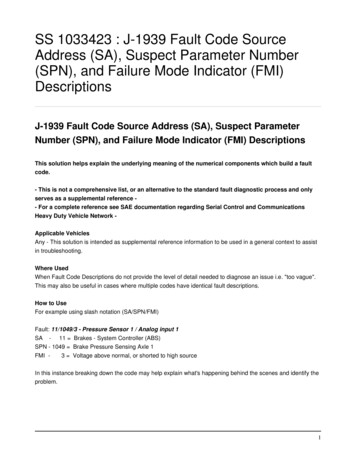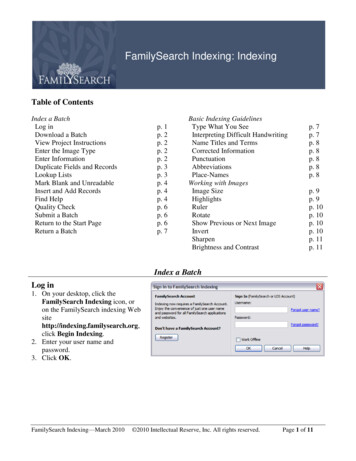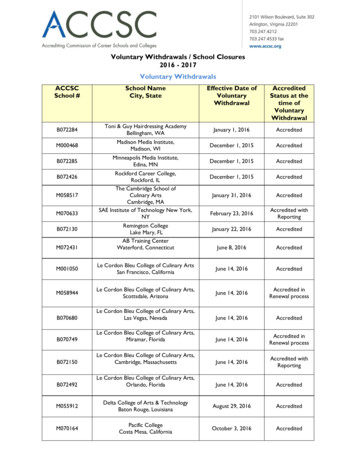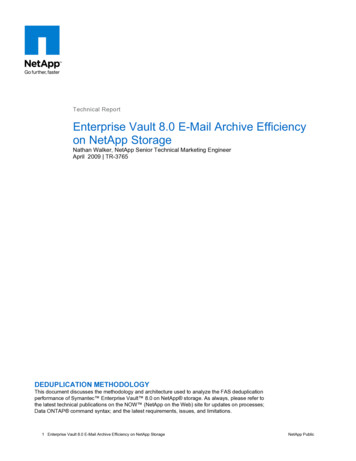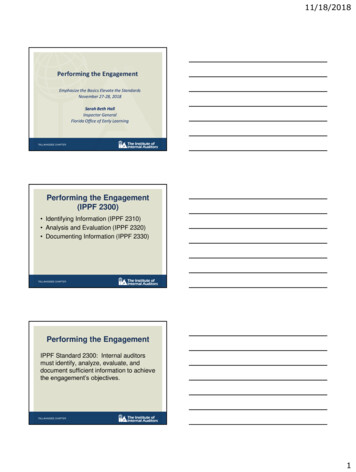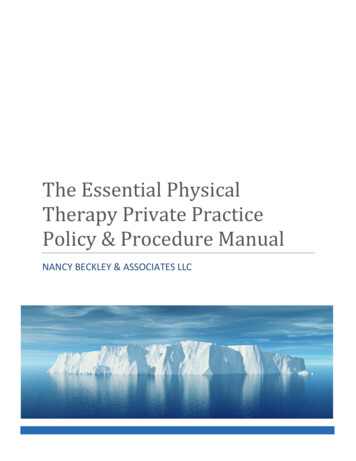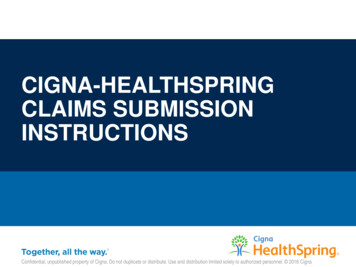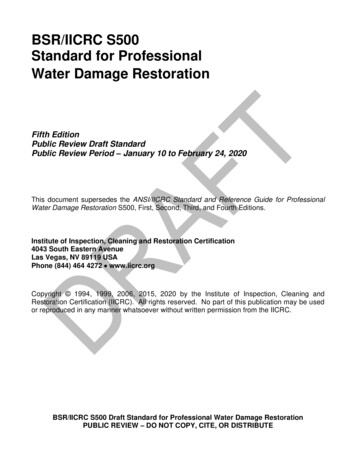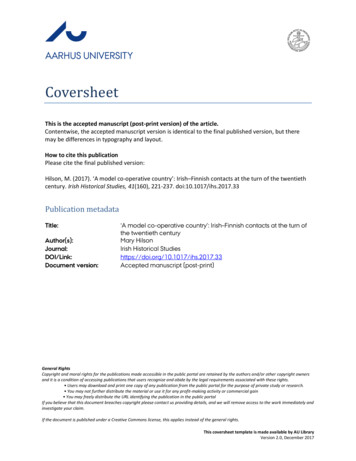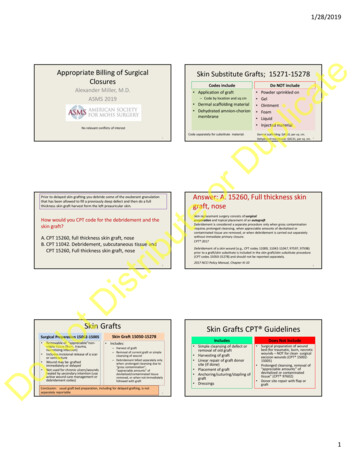
Transcription
1/28/2019Appropriate Billing of SurgicalClosuresCodes includeAlexander Miller, M.D.ASMS 2019 Application of graft– Code by location and sq cm Dermal scaffolding material Dehydrated amnion-chorionmembraneDo NOT include Powder sprinkled onGelOintmentFoamLiquidInjected materialupNo relevant conflicts of interestlicateSkin Substitute Grafts; 15271-15278Code separately for substitute material:Dermal scaffolding: Q4110, per sq. cm.Dehydrated membrane: Q4131, per sq. cm.2orD1Answer: A. 15260, Full thickness skingraft, nosebutePrior to delayed skin grafting you debride some of the exuberant granulationthat has been allowed to fill a previously deep defect and then do a fullthickness skin graft harvest form the left preauricular skin.Skin replacement surgery consists of surgicalpreparation and topical placement of an autograftDebridement is considered a separate procedure only when gross contaminationrequires prolonged cleansing, when appreciable amounts of devitalized orcontaminated tissue are removed, or when debridement is carried out separatelywithout immediate primary closure.CPT 2017How would you CPT code for the debridement and theskin graft?A. CPT 15260, full thickness skin graft, noseB. CPT 11042. Debridement, subcutaneous tissue andCPT 15260, Full thickness skin graft, noseistriDebridement of a skin wound (e.g., CPT codes 11000, 11042-11047, 97597, 97598)prior to a graft/skin substitute is included in the skin graft/skin substitute procedure(CPT codes 15050-15278) and should not be reported separately.2017 NCCI Policy Manual, Chapter III-104D3NotSkin Grafts Do Removable of “appreciable”nonviable tissue (burn, trauma,necrotizing infection)Includes incisional release of a scaror contractureWound may be: graftedimmediately or delayedNot used for chronic ulcers/woundshealed by secondary intention (useactive wound care management ordebridement codes)Skin Grafts CPT GuidelinesSkin Graft 15050-15278Surgical Preparation 15002-15005 IncludesIncludes:– Harvest of graft– Removal of current graft or simplecleansing of wound– Debridement billed separately onlywhen: prolonged cleansing due to“gross contamination”,“appreciable amounts” ofdevitalized/contaminated tissueremoved, or when not immediatelyfollowed with graftConclusion: usual graft bed preparation, including for delayed grafting, is notseparately reportable Simple cleansing of defect orremoval of old graft Harvesting of graft Linear repair of graft donorsite (if done) Placement of graft Anchoring/suturing/stapling ofgraft DressingsDoes Not Include Surgical preparation of woundbed (for traumatic, burn, necroticwounds – NOT for clean surgicalexcision wounds (CPT 1500215005)Prolonged cleansing, removal of“appreciable amounts” ofdevitalized or contaminatedtissue” (CPT 97602)Donor site repair with flap orgraft51
1/28/201915050 Pinch Graft Single or multiple grafts, tocover area up to 2 cmdiameter Not on face15200, 15220, 15240, 15260 : FTSG Routine wound bed preparation,including debridement, is notseparately reportable Excision, Mohs surgery to createdefect are separately reportable How a graft is harvested does notmatter (dermatome, freehandblade) Code selection based upon:How would the evaluation, suture removal and patientcounseling be CPT coded?A. CPT 99202, as the patient is new to the physicianB. CPT 99212, as the patient is not new to thedermatology group practiceC. No charge and no code8orDup– Site of wound– Size of wound (sq cm surface area)One week after you do a flap repair following an excision of a cheek BCC yourpatient returns to your group practice for suture removal. As you are away,another physician of your specialty who is in your group practice evaluates thepatient, who is new to this physician, removes the sutures, and advises onaftercare.licatePinch Graft vs. Full thickness graftcodingGlobal Surgical Follow-up PeriodsAnswer: C. No charge and no codebute0 Days: MinorProcedureWhen services are furnished by a physician of the same specialty within a grouppractice the services are considered part of the global surgical package. Separatecoding/billing is not appropriate.Biopsy (11100 )If the patient were new to a physician of a different specialty within the group practiceor the physician of any specialty were independent of the group practice, then anappropriate E/M office visit would be billable.Shave removal(11300 – 11313)Debridement(11000, 11011-42)Mohs (17311 –17315)istriGlobal Surgery Fact Sheet, lSurgery-ICN907166.pdfDestruction(17000 - 17286)90 Days: MajorProcedureFlapsGraftsExcisions (11400 –11646)Tissue ExpandersRepairs (12001 –13153)Destruction ofVascular ProliferativeLesion (17106 – 08)Dermabrasion,No modifier is needed when an E/M or a surgical service isChemical Peeldone at any day following a zero day global surgical procedureD910 Days: MinorProcedureNotComplex RepairDoExcision of standing cones (Burow triangles, dog ears) does not justify a complexrepair code.Complex repair Layered closure plus “extensive” undermining,retention sutures, scarrevision, debridement (fortraumatic lacerations,avulsions) Nothing is said in CPT aboutstanding cone removal Excision of standing conesStanding coneslengthens the line of closure(Burow triangles) Complex repair codes arestratified via location and lengthCase 1You excise a scalp tumor andrepair the defect with a “kitegraft”.You bill:A) Full thickness skin graft andcomplex repairB) Skin graft only122
1/28/2019Case 1: AnswerlicateCase 2You repair a nasal defect with both an adjacent tissue rearrangement (CPT 14060) anda full thickness skin graft (CPT 15260).B) Skin graft only is coded and billedQ: Are both a skin graft and a flap code billable? (Yes/No)CPT instructs that harvesting and repairing the skin graft donor site is included in the skingraft code (and its valuation).upo If the repair of the donor site requires a flap or another graft, then that is billable14orD13Flap codingA: Yes, both flap and graft are reasonable tobillistri NCCI edits do not pair CPT 14060 and15260. However, billing Medicare for the twoprocedures linked to one diagnosis code(same site) will very likely result in a denialof payment. Use modifier .76 to differentiate that twoseparate procedures were done on one andthe same site.Proper CPT codedetermined by: Location ofdefect(predominantlyon eyelid andnose) NOT by flapsource (cheek) Sum the sq cmof defect sqcm of raisedflapbuteCase 2: AnswerNotD3 mos. post opCase 3Case 3: AnswerThree weeks after excising a basal cell carcinoma on the nose and repairing surgicaldefect with a cheek to nose interpolation flap you divide and inset the flap.Three weeks after excising a basal cell carcinoma on the nose and repairing thesurgical defect with a cheek to nose interpolation flap you divide and inset the flap.You bill:You bill:A.B.C.D.A.B.C.D.DoCPT 15630, division and inset, at noseCPT 15620, division and inset, at cheekCPT 15620.58, division and inset, at cheekCPT 15630.58, division and inset, at nose17CPT 15630, division and inset, at noseCPT 15620, division and inset, at cheekCPT 15620.58, division and inset, at cheekCPT 15630.58, division and inset, at nose183
1/28/2019Both the attachment of the flap to the nose (CPT 15576) and the division and inset atthe nose (CPT 15630) are reported based upon the site of the surgical defect to whichthe flap is attached.Modifier 58 is appended because the division and inset occurs during the 90 dayglobal period of the initial interpolation flap procedure.Modifier 58: Staged or Related Procedure or Service by the SamePhysician or Other Qualified Health Care ProfessionalDuring the Postoperative Period: Code determined by recipientsite Excision of lesion is reportedseparately (unlike adjacenttissue rearrangement) Primary closure of flap donorsite included in code Division and inset: CPT 15600-15630 Determined by recipientlocation of the flapCPT 15576: cheekto noseinterpolation flapCPT 15630:sectioning of flap,at noseAdd modifier .58 toindicate stagedprocedureupCPT Assistant, March 2010, page 4licateInterpolation FlapsCase 3: AnswerCase 4: Bilateral advancement flapsYou code for:A) One flap (adjacent tissue rearrangement)B) Two flaps (adjacent tissue rearrangements)orD19Case 4: AnswerA) One flap (adjacent tissue rearrangement)buteSum the area of the defect plus that of each of the raised flapsto generate the appropriate CPT code: 14021CPT Assistant , July 2008, pg. 51 month postoperativeistriHow about this case? How to code?Bilateral advancement-rotation flapsD2 stage Mohs defectNotCase 5: Determining appropriate flap codeSum: Area of defect areas of raised flaps,including the Burows triangles.CPT illustrates squares and quadranglesCase 6: Cheek advancementThis should be coded as:A) Flap (adjacent tissue rearrangement)B) Complex repairDoAreas Square: base x height Triangle: ½ base x height Circle: 𝐴 𝜋𝑟4
1/28/2019licateCase 7: Nasalis muscle based flapCase 6: AnswerA) CPT 14060, adjacent tissue rearrangement, nose, 10 sq cmB) CPT 15740, flap, island pedicleC) CPT 15732, muscle, myocutaneous, or fasciocutaneous flap, head and neckB) Complex repairCPT :“Undermining alone of adjacent tissues to achieve closure, withoutadditional incision, does not constitute adjacent tissue transfer, seecomplex repair codes 13100-13160)”6 days post-oporDupCPT Assistant, April 2014, page 10:“Excess tissue removal does not constitute adjacent tissue transfer.”That is, removal of standing cones/dog ears/ Burows triangles doesnot make it a flap.Case 7: AnswerCoding nasalis muscle based and V-Y flapsbute The nasalis muscle flap is really an island advancement or V-Y flap. 15740, Island pedicle requires “identification and dissection of an anatomically named axialvessel”. 15732, Myocutaneous flap refers to large muscle (temporalis, masseter, sternocleidomastoid,levator scapulae) based flaps15740: Islandpedicle15733:Myocutaneous flapIncludes V-Y plastyRequires ID and dissection ofnamed axial vesselNew code for 2018Sum excision plus raised flapdefects“For V-Y sq flaps withoutclearly defined anatomicallynamed vessels see 1400014302”Has named vascular pedicle(buccinators, genioglossus,temporalis, masseter, SCM,levator scapulae)istri14060, 14061:Flap, noseNotD1 month postopCase 8: Nose flap or cheek flap?DoA) Cheek flap, 14041B) Nose flap, 14061Case 8: AnswerA or B Retain consistency: If billing diagnosis is a nosetumor, and a cheek flap is coded,that may create someadjudication questions. Correlate the site diagnosis withthe site specific repair code Additional approach: bill for theanatomical site that contains greaterthan 50% of the surface area of thedefect5
1/28/2019licateCase 9: Lip wedge repairCase 9: AnswerSCC lower lip Mohs excision defect repaired with a lip wedge excision-repair.You code:A) CPT 40520, V-excision with primary direct linear closureB) CPT 40654, Repair lip, full thickness, over one-half vertical height, or complexB) CPT 40654, Repair lip, full thickness, over one-half vertical height, or complexLip repair codes: 40650 Repair lip, full thickness, vermilion only 40652 up to half vertical height 40654 over one-half vertical height, or complexCase 10: Two Mohs defects, one flapCase 10: AnswerA) 14301: Adjacent tissue rearrangement, any area, defect 30.1 – 60.0 sq cmWhy? Two defects combined to close as one, with two flaps.Areas of defects plus that of raised flaps summed.1 month follow-upDoNotDistributeFor reconstruction, code:A) 14301: Adjacent tissue rearrangement, any area, defect 30.1 – 60.0 sq cmB) 14021 x 2: Adj. tissue rearrangement, scalp, defect 10.1 – 30.0 sq cmorDupLip limits: Upper lip: extends from inferior edge of the vermilion to thenasal alar, nasal sill and cheek fold Lower lip: extends from superior edge of the vermilion tothe mental creaseCase 11: Repair with flap and graftA) Code for both flap,14060, and graft,15260B) Code for flap or graftonly, not bothC) Code for both graft,15260, and graft,14060.59.76Case 11: AnswerA) Code for both graft, 15260 and flap, 14060.59.76.5 months post op6
1/28/2019Which one is not an adjacent tissuerearrangement/flap? Side-to-side closure shortened with an M-plasty No tissue rearrangement done Choose appropriate intermediate or complex repaircodeA. Intermediate repairB. Complex repairC. Simple repairlicateZ-plastyM-plastyW-plastyV-Y plastyA. Intermediate repairB. Complex repairC. Simple repairWhy?CPT Assistant, February 2007, pg. 10: For excision: if no undermining, then code for the maximumexcision diameter only For repair: if simple, then the lengthof repairCPT : “The repaired wound(s) should be measured andrecorded in centimeters, whether curved, angular, orstellate.”Repair length:A. Maximum diameter of defect?B. Circumference of defect? (Approximately πd)Distri“If a Mohs surgery defect is repaired with a purse string suture,how should it be reported?AMA CommentTypically, this would require a simple repair (codes 1200112018). If, however, extensive instrumentation or undermining isneeded, intermediate repair may be reported (codes 1203112057).”Measuring/Reporting purse string closurelengthbutePurse string suture after Mohs excisionorDupA.B.C.D.Purse string sutureNotMeasuring/Reporting purse string closurelength For excision: if no undermining, then code for the maximumexcision diameter only For repair: if simple, then the lengthof repairDoCPT : The repaired wound(s) should be measured andrecorded in centimeters, whether curved, angular, orstellate.”Repair length:A. Maximum diameter of defect?B. Circumference of defect (Approximately πd)7
Debridement of a skin wound (e.g., CPT codes 11000, 11042-11047, 97597, 97598) prior to a graft/skin substitute is included in the skin graft/skin substitute procedure (CPT codes 15050-15278) and should not be reported separately. 2017 NCCI Policy Manual, Chapter III-10 CPT 2017 Skin Grafts Surgical Preparation 15002-15005
